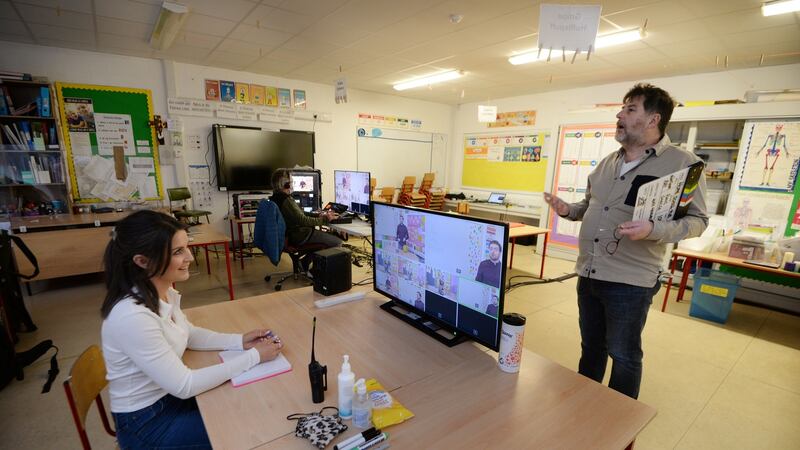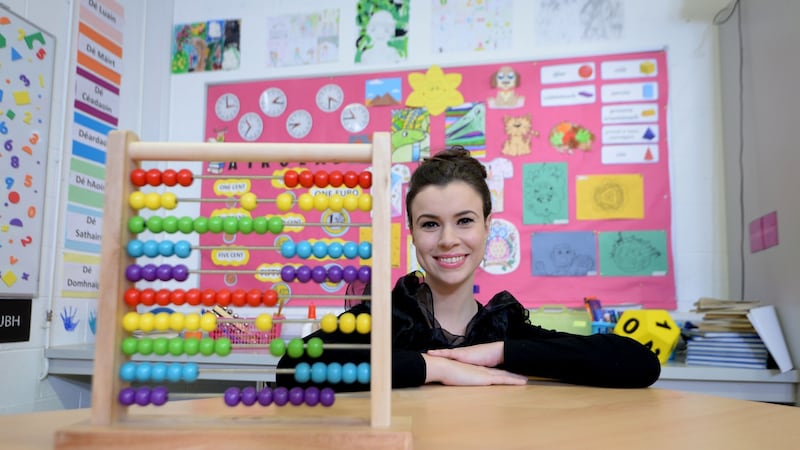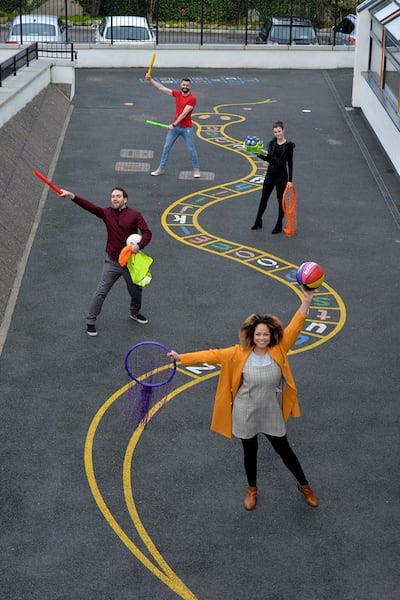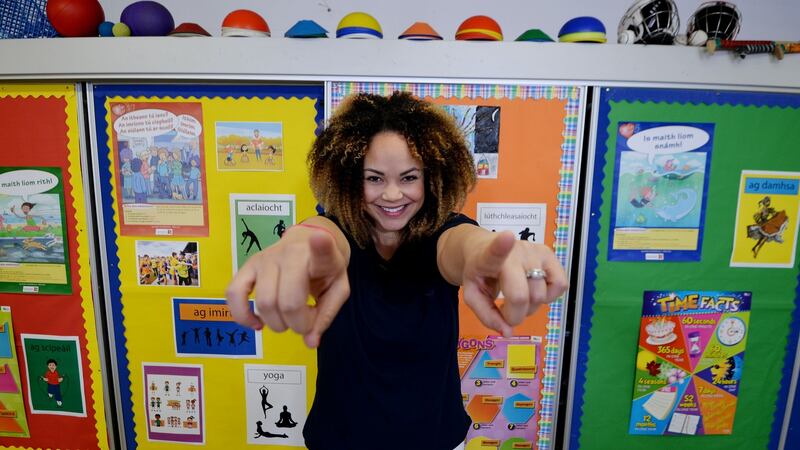Cúán Mac Conghail, series producer of Home School Hub and company director of the production company Macalla Teoranta, was in Mayo when lockdown was first announced last March. He considered just staying there for the duration. Then he got a call from Suzanne Kelly, Head of Children and Young People's Programming in RTÉ. She said: "What are the chances of you being able to get a school up on air?"
“Eight days later, we were on air,” says Mac Conghail. “I don’t think I slept over that eight days. It was nuts. I look back and it’s a blur... The next thing I remember it was Easter.”
Along with The Den, Home School Hub and its sequel After School Hub were the Irish television triumphs of 2020 and they were recommissioned for many more hours of programming in the early days of 2021. The Home School is, if you haven't seen it, school on the telly featuring some of the kindest, most entertaining teachers you could hope for in actual classrooms, cool puppets and animation, as well as some excellent guest appearances from people like Sinead Burke and Lenny Abrahamson.
The speed at which it went to air goes against most contemporary television practice. And the Department of Education isn't always used to moving so quickly. There were a lot of Zoom meetings. When Mac Conghail realised it was going to take a little too long for them to find a school for him, he just asked the headmaster of Scoil Lorcáin, the school his children attend in Monkstown.
"There were lots of unknowns in the early days," says Aoife Hendrick, the show's director. "We even discussed all getting tested and going somewhere together and not coming out. We had no idea what Covid was, or how it was going to affect us day to day."

Their secret weapons were their first three muinteoirí – Ray Cuddihy, Clíona Ní Chiosáin and John Sharpson – who they had worked with in the past (Cuddihy and Ní Chiosáin had been on RTÉ Jnr's Tír na nÓg, while Sharpson had been in a show called Bright Sparks). They were uniquely adept at presenting television while also being fully trained teachers.
“We were blessed we had a relationship with all three of them,” says Hendrick. “They couldn’t have been a better team because of the experience they have and how much they care about both actually as a vocation.”
Mac Conghail describes Sharpson as “a messer in the nicest sense” and Ní Chiosáin as “bonkers, and I say that with love”. And he notes that the often-puppet-wielding Cuddihy’s “calming and warm” persona was very important for luring kids into the show. “He was kind of like the child Catcher in Chitty Chitty Bang Bang.”
"Every TV convention has gone out the door, but what you have is a genuine piece of absolutely wonderful TV"
Cuddihy was one of the first people Kelly from RTÉ called. “She knew that I’d just gone back to study teaching,” he says. “I’d just finished a master’s in September 2019. I was very, very confident that this would work. It was more about convincing other people because it goes against all conventions of making television in some ways. So I got busy then making demos… [with teaching] I had been kind of bringing TV into the classroom, and then with this opportunity, I was able to bring the classroom into TV.”

Ní Chiosáin had been acting since she was in her teens (she had been the star of the very popular TG4 show Aifric) and has become a teacher since. More recently she's been juggling her day job as a teacher with children's television, which she describes as "a hobby".
Sharpson had been going the other direction. Before lockdown a five-year career break from his teaching job was ending and he had decided to give up his permanent job in order to pursue TV presenting for a little longer. He laughs. “And then bang! the apocalypse happened. And I went ‘Oh God’. Cúán gave me a call and said, ‘Do you want to teach on TV?’ and I nearly got whiplash from the U-Turn I did.”
The teachers worked from their own lesson plans and there was a bit of trial and error at the start. They realised certain parts of the curriculum didn’t work too well on television so they had to get creative. “Generally speaking, it goes against what you’re literally supposed to be doing in a classroom. You’re supposed to be, as they say, ‘a guide on the side, not a sage on the stage,’” says Ní Chiosáin. “If you’re doing all the talking in a classroom, you’re doing something wrong basically. But it evolved for me.”
“You have to find a way around things,” says Cuddihy. “If it’s a Gaeilge class it needs to be conversational. So there I was with the two sock puppets. I think we all found ways to kind of fill the gaps. For me the real difficult part of teaching is keeping a hold on everybody, behavioural stuff. The creative stuff is just pure joy. For me we’re doing the real joyous part of teaching.”

They were helped throughout by Prof Emer Ring, Dean of Education (early childhood and teacher education) at Mary Immaculate College, Limerick. "We were really always trying to talk to the kids at the back of the class and knew that if we could get them it would work as a programme," says MacConghaile. "I would have been that kid. The philosophy we had all the time was that this was for those kids and for the parents of those kids. Because some kids read for themselves and they're self-motivated, but what happens if you're at home with three feckers?" he laughs. (He does not think they are feckers.)

With that in mind, it was important for Mac Conghail and Hendrick for the show to be on TV, not online ("because not everyone has a computer") and they made a big effort to represent all sorts of children in their programme. Some people, Mac Conghail feels, missed the point. "Professors from departments in UCD, TCD, Galway and Limerick… wrote this letter that we were causing pedagogical harm because Ray had drawn a circle – in a maths class – and said, 'there's a circle' and then he drew a line in the middle 'that's half a circle'…. And he went into doing fractions. And apparently that's not half of a circle, because you haven't worked it out properly… I loved the notion that all these college professors were sitting down in their pyjamas eating their Sugar Puffs and critiquing our classes… That's where Emer Ring was brilliant for us because she was our safety blanket… with Emer we were able to say, 'It's been approved, it's fine'... We're not school. We're very clear about that. We are not replacing teachers."
There was silence from grumpy professors after that. Many teachers got in touch to say they were using the ideas on the show with their classes. Parents were relieved to have something educational for children to watch. Broadcasters in other countries got in touch about using the format. And children loved it. They participated and sent in their artwork and videos of themselves engaging in the lessons and activities.
“There was an amazing feedback loop of the videos that the kids send in,” says Cuddihy. “It wasn’t something that I was really thinking about when we first started creating classes. I started thinking about things in a really kind of creative way. I really started trying to do Andy Kaufman-style stuff. I was doing atmospheric listening and playing with the medium of television. I did one class and was like, ‘Okay, so you stand in front of your TV, and you mirror me.’ And then we got a video of kids standing in front of their TV doing this – filmed by their parents. That’s trippy. That feedback loop became part of it [because] when you’re talking to a camera, you’re talking to a vacuum.”
They had a wide selection of guests from Ryan Tubridy to a (very popular) bus driver. They did special segments on high-achieving women. The teachers experimented. Ní Chiosáin spoke about mental health. A relative newcomer to the show, PE teacher Emer O'Neill did a hugely popular segment on racism, which has been taken up for use by Olympics Ireland and the INTO. "Parents were saying that every time they went to go find resources to teach their kids about racism it was all very American and nothing for an Irish person by an Irish person that was directed towards that primary school age group," she says. "It's probably one of the best things I've ever done in my life. It was really special to me."

What is delightful about Home School Hub for this occasional viewer is that it’s creative and kind and slow. It defies a lot of contemporary television logic. Sharpson tells me about the first rather frenetic demo he did. “Straight away I had the toilet rolls out and I was right up into the camera. I went gung ho into this lesson and it lasted three minutes and I was knackered. They were like ‘Whoa! Slow down!’”
Cuddihy says that Sesame Street was a big inspiration for him as both a teacher and puppeteer. "If think about it the most basic Henson technique, it's all in the eyeballs. Like, the whole thing is like the eyeballs [of the muppet] make contact with the kids watching. Anything he says is down the lens. I've been thinking about this on a profound level for years. My favourite clips ever on TV is when Paul Simon is on Sesame Street… You get kids dancing. They're turning their backs to the camera. They're walking around. Every TV convention has gone out the door, but what you have is a genuine piece of absolutely wonderful TV."
"We got the cutest and saddest letter from a brother and sister in their 70s from Kerry, alone and isolated"
“And Sesame Street was one of these shows that weren’t afraid to talk about controversial issues as well,” adds O’Neill. “They’ve taken stands like on Black Lives Matter. They’ve talked about LGBTQ [issues], all in friendly terminology for kids. And I think we’re kind of doing the same thing.”
Are they the most famous people in Ireland right now for a certain demographic? They laugh. Ní Chiosáin, who is somehow managing to film the Home School Hub whilst working as a full-time teacher, says that when parents were collecting book boxes shortly before our conversation, “the kids are in the back of the car roaring out the window saying that they were watching it this morning.” She misses being in a classroom with them. “I nearly crawled in the car window to them.”

“I was at traffic lights on my bike and this kid went by not too steady on the stabilisers staring at me and the next thing she was gone over,” says Cuddihy. “It’s a very positive thing to be part of. A lot of kids respond by tugging on the parent’s hand and saying ‘wait a second I know that guy.’”
“I was in the park and a guy came over and said, ‘my daughter was wondering could she use her pocket money to buy you a 99?’,” says Sharpson. “It was the best 99 I ever had. Then there are other times when a kid walks by and their jaw drops and you give them a wave and the dad wonders ‘Who’s that weirdo?’”
It’s not even just kids. “We got the cutest and saddest letter from a brother and sister in their 70s from Kerry, alone and isolated,” says MacConghail. “It said that if they had this when they were kids, their lives would have been entirely different. And that sort of unexpectedly made me well up.”

The success of the show (the first episode had 250,000 viewers) makes RTÉ’s decision to hugely cut back on the production of young people’s programming in 2016 seem even more of a mistake than it was then. Some of my interviewees lost work at the time. They note that the huge love and nostalgia that’s out there for shows like The Den can only exist because an investment was made in children’s television in the first place. And, as MacConghail says, investing in children’s television is also an investment in a future audience who are already very distracted by other outlets. “To have a chance to do this with the help of Suzanne Kelly, who is in there really trying her best,” says Cuddihy, “it’s a bit of an indication of what can be achieved.”
What do they think is at the core of Home School Hub’s success? “I think what Home School has that’s different to other children’s shows is that we’re all extremely careful about not coming across as condescending towards children,” says Ní Chiosáin. “They’re just very young people. They’re not aliens. We speak to them like they’re human beings.” Like The Den, she says, Homes School Hub is “relaxed. It’s a normal conversation. It’s enjoyable as a human.” She laughs. “I’m sorry, I sound like an AI. I keep saying ‘human’.”
“Kids are part of this narrative we’re living through,” says Cuddihy. “I open up every show with, ‘We’re bringing the classroom into your sitting room…. So how are you feeling today? Are you okay, today? You know what I did? I called my mam last night, because I’ve got to make sure that she’s okay. And you know what? It’s good to talk.’ So the narrative of these absolutely unique times that we’re in really allows us that extra bond with the audience. ‘There’s a camera in front of me and you’re sitting in your living room You’re learning from me. And that is great. Fair play for sitting down with us.’ And that narrative includes them and it just puts us all in the same boat.”















